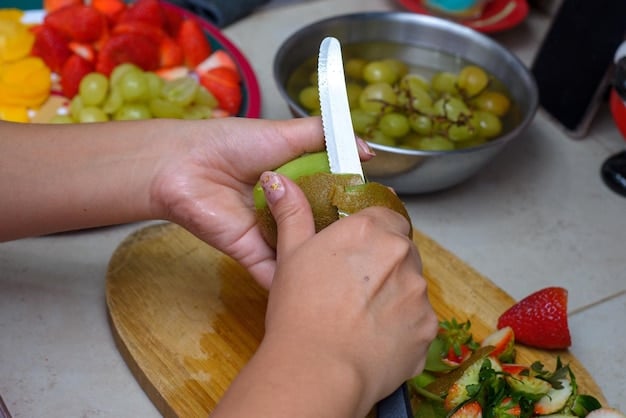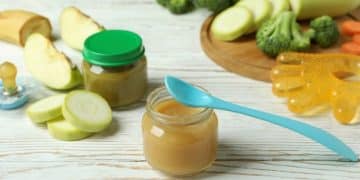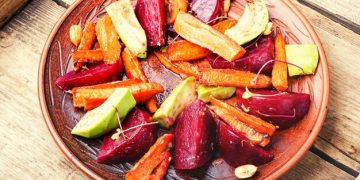Choking Hazards: 10 Foods to Avoid for Babies Under One

Understanding choking hazards is crucial for parents; certain foods pose a significant risk to babies under one year old due to their size, shape, and texture, necessitating careful avoidance.
Introducing solids to your baby is an exciting milestone, but it’s crucial to be aware of potential dangers. One significant concern is the risk of choking. This guide will outline the top 10 choking hazards: 10 foods to avoid until your baby is one year old, helping you ensure a safer feeding experience for your little one.
Understanding Choking Hazards in Infants
Choking is a terrifying experience for both baby and parent. Infants are particularly vulnerable because their swallowing skills are still developing, and their airways are narrow. Therefore, understanding what constitutes a choking hazard is paramount for parents as they navigate the world of solid foods.
Why Are Babies More Susceptible to Choking?
Several factors contribute to an infant’s increased risk of choking. Their airways are smaller and less developed compared to older children and adults. This means that even small pieces of food can easily obstruct their breathing. Coordination between chewing and swallowing is also a skill that develops over time, leading to potential difficulties in handling certain textures.
Key Characteristics of Choking Hazards
Foods that pose the greatest choking risk typically share certain characteristics. These include being small, round, firm, and/or sticky. These attributes make it easier for the food to become lodged in a baby’s airway. Understanding these properties will help you identify and avoid potentially dangerous foods.

Consider these points when preparing food for your baby:
- Size matters: Cut foods into small, manageable pieces, smaller than the size of a pea.
- Texture is important: Avoid hard, crunchy, or sticky foods that are difficult for babies to chew and swallow.
- Preparation is key: Cook foods until they are soft and easily mashed.
By being diligent and informed, you can significantly reduce the risk of choking and create a safer environment for your baby to explore new flavors and textures.
The Top 10 Choking Hazards for Babies
Now that we understand the general principles of choking hazards, let’s delve into the specific foods that are best avoided until your baby turns one.
1. Whole Grapes
Whole grapes are a classic choking hazard due to their size and round shape. They can easily become lodged in a baby’s airway, completely blocking it. Always cut grapes into quarters before serving them to your child.
2. Hot Dogs
Hot dogs, even when cut into small pieces, can still be a choking hazard because they are cylindrical and compressible, making them easily lodged in the throat. Consider removing it from your baby’s diet. If not, be extremely careful to cut them into very small, irregular pieces to reduce the risk.
3. Nuts and Seeds
Whole nuts and seeds are firm and difficult for babies to chew properly. They can also easily get stuck in the airway. Nut butters should be spread thinly to prevent them from sticking to the roof of the mouth or throat.
Here are some other foods to be cautious of:
- Popcorn: Kernels can be difficult to chew and easily aspirated.
- Hard candies: Their shape and hardness make them a significant choking hazard.
- Raw vegetables: Carrots, celery, and other raw veggies should be cooked until soft.
Keeping these foods off your baby’s menu will ensure a safer introduction to solids and provide you with peace of mind during mealtimes.
Cutting Food Safely: A Step-by-Step Guide
Properly preparing your baby’s food is essential to minimize the risk of choking. Even seemingly safe foods can pose a threat if they are not cut or cooked appropriately. Here’s a comprehensive guide to cutting food safely for your baby.
General Guidelines for Food Preparation
Before we dive into specific examples, let’s cover some general rules. Always wash fruits and vegetables thoroughly before cutting. Remove any seeds, pits, or stems that could pose a hazard. Cook foods until they are soft and easy to mash with a fork.
Specific Cutting Techniques
Different foods require different cutting techniques. For grapes and cherries, quarter them lengthwise. For hot dogs, cut them into thin strips or small, irregular pieces. Hard fruits and vegetables, like apples and carrots, should be cooked until soft or grated. The goal is to make food easy for your baby to manage in their mouth.
Consider these tips as well:
- Use appropriate tools: Invest in baby food scissors or a small paring knife for precise cutting.
- Be mindful of shape: Avoid round or cylindrical shapes that can easily block the airway.
- Supervise meal times: Always keep a close eye on your baby while they are eating.
Mastering these cutting techniques will empower you to provide your baby with a variety of nutritious foods while significantly reducing the risk of choking.

Safe Alternatives to Common Choking Hazards
While some foods are best avoided, it doesn’t mean your baby has to miss out on essential nutrients. There are plenty of safe and delicious alternatives to common choking hazards.
Substituting High-Risk Foods
Instead of whole grapes, try offering mashed or pureed grapes. Replace hot dogs with well-cooked and shredded chicken or turkey. Instead of whole nuts, consider finely ground nut flours or butters spread very thinly. The key is to modify the food’s texture and presentation to make it safer for your baby.
Exploring Nutrient-Rich Options
Focus on nutrient-rich foods that are naturally soft and easy to swallow. Avocado, sweet potato, banana, and well-cooked carrots are excellent choices. These foods provide essential vitamins and minerals while being gentle on your baby’s developing swallowing skills.
Thinking about alternatives?
- Cooked fruits and vegetables: Steaming or roasting softens fruits and vegetables, making them easier to chew and swallow.
- Purees and mashes: These are excellent options for introducing new flavors and textures.
- Soft proteins: Shredded chicken, fish, or tofu are good sources of protein that are easy to manage.
By thoughtfully selecting and preparing your baby’s food, you can provide a diverse and nutritious diet without compromising their safety.
Recognizing the Signs of Choking
Even with the best precautions, choking incidents can still occur. Knowing how to recognize the signs of choking is crucial for reacting quickly and effectively. Early detection can make all the difference.
Key Indicators of Choking
The signs of choking can vary depending on the severity of the obstruction. Common indicators include gagging, coughing, or difficulty breathing. Your baby may also turn red or blue in the face, indicating a lack of oxygen. In severe cases, they may be unable to cry or make any noise at all.
Differentiating Choking from Gagging
It’s important to distinguish between choking and gagging. Gagging is a normal reflex that helps prevent food from going down the wrong way. Babies often gag when they are first introduced to solids, as they learn to manage new textures. Gagging is usually accompanied by coughing and spitting, and the baby is able to clear their airway on their own.
If you think your baby is choking, look for these signs:
- Inability to cough or cry: This indicates a complete airway obstruction.
- Bluish skin color: This signals a lack of oxygen and requires immediate action.
- Loss of consciousness: This is a severe sign and requires emergency medical attention.
Prompt recognition of choking signs can empower you to take immediate action and potentially save your baby’s life.
What to Do If Your Baby Is Choking
Knowing how to respond when your baby is choking is essential. Quick and effective action can dislodge the obstruction and restore their ability to breathe. Here are the steps you should take if your baby is choking.
Infant Choking First Aid
If your baby is choking but still able to cough, encourage them to continue coughing. If they are unable to cough or breathe, you’ll need to intervene. Start by placing the baby face down over your forearm, supporting their head and jaw. Give five firm back blows between their shoulder blades using the heel of your hand.
If Back Blows Are Unsuccessful
If the back blows don’t dislodge the object, turn the baby face up, supporting their head. Place two fingers on the center of their chest, just below the nipple line. Give five quick downward thrusts. Alternate between back blows and chest thrusts until the object is dislodged or the baby becomes unresponsive.
Remember to follow these steps carefully:
- Call for help: If possible, have someone call emergency services while you administer first aid.
- Stay calm: It’s important to remain calm so you can provide effective assistance.
- Seek medical attention: Even if you successfully dislodge the object, have your baby checked by a doctor to ensure there are no further complications.
Knowing these steps and practicing them in advance can help you respond confidently and effectively in a choking emergency.
| Key Point | Brief Description |
|---|---|
| ⚠️ Grapes | Always cut grapes into quarters to prevent choking. |
| 🌭 Hot Dogs | Avoid hot dogs or cut them into very small, irregular pieces. |
| 🥜 Nuts | Nuts should be avoided in whole form; use nut butters thinly. |
| 🍬 Hard Candies | Hard candies are a significant choking hazard and should be avoided. |
FAQ
▼
Grapes can be safely introduced once your child is able to chew thoroughly, typically around four years old, and even then, they should still be cut into smaller pieces. Always supervise your child when they are eating grapes.
▼
Whole nuts are choking hazards, but nut butters can be introduced sparingly if spread thinly. Be cautious of allergies and introduce them gradually. Always consult with your pediatrician before introducing nut butters.
▼
Food pieces should be smaller than half an inch in size to minimize the risk of choking. Specifically, aim for pieces no larger than the size of a pea. Smaller sizes are easier for babies to manage.
▼
Gagging is usually a normal reflex. Stay calm and allow your baby to work through it themselves. Avoid sticking your fingers in their mouth, as this can push the food further back. Supervise them closely until their airway clears.
▼
Honey should always be avoided for babies under one year due to the risk of botulism. Additionally, foods with high sodium or sugar content are not recommended. Always prioritize whole, unprocessed foods.
Conclusion
Understanding and avoiding choking hazards: 10 foods to avoid until your baby is one year old is crucial for ensuring a safe and healthy start to solid foods. By following the guidelines, preparing food safely, and knowing how to respond in an emergency, you can create a positive and worry-free feeding experience for you and your baby.





